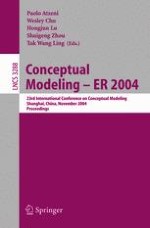2004 | Buch
Conceptual Modeling – ER 2004
23rd International Conference on Conceptual Modeling, Shanghai, China, November 8-12, 2004. Proceedings
herausgegeben von: Paolo Atzeni, Wesley Chu, Hongjun Lu, Shuigeng Zhou, Tok-Wang Ling
Verlag: Springer Berlin Heidelberg
Buchreihe : Lecture Notes in Computer Science
Enthalten in: Professional Book Archive
